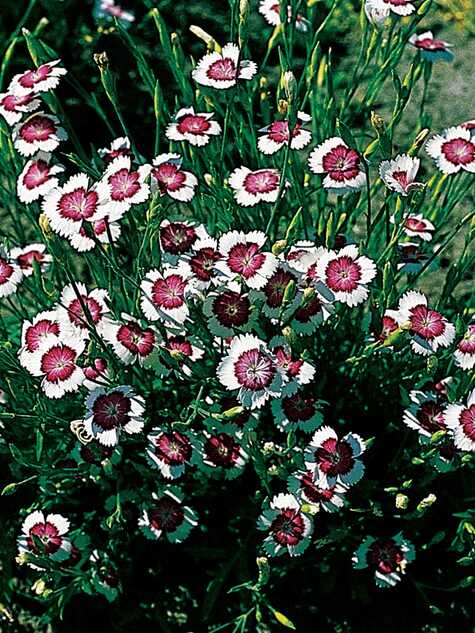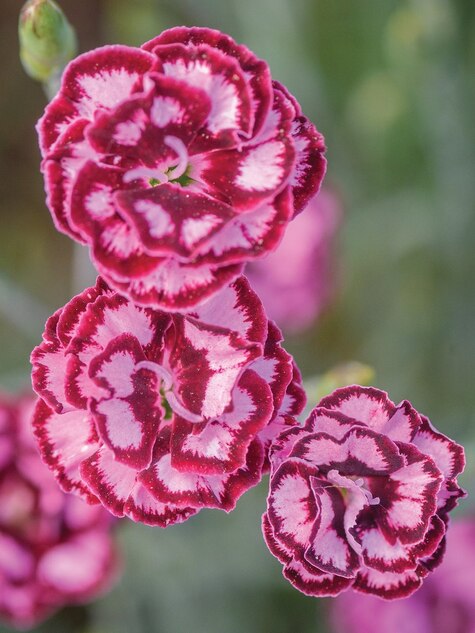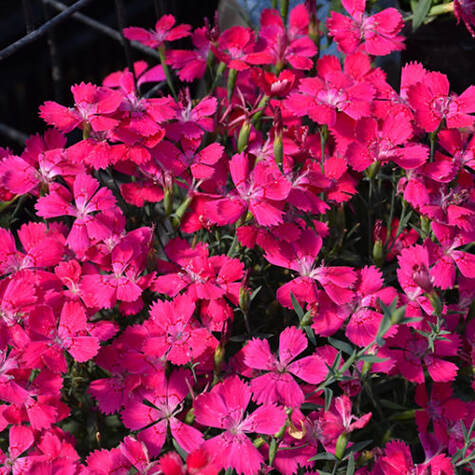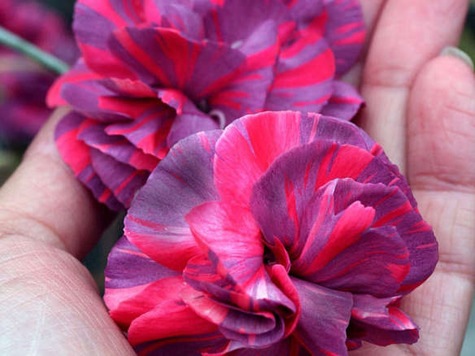Dianthus
by CMG Kathleen S.
If you have the proverbial “brown thumb” and are looking for a plant that is practically indestructible, dianthus may be it. This is a plant with pretty single or double blooms in white, pink, lilac or red solids, combinations and variegations. All blooms have jagged edged petals and appear like they were cut with pinking shears; hence their common name “Pinks”.
Dianthuses grow from 4 to 36 inches in height and 4 to 24 inches in width. Their foliage is a beautiful green to bluish green color that resembles blades of grass. There are many varieties and they can be perennials, biennials and annuals.

Dianthus ‘Artic Fire’ from Burpee.com
Dianthuses need around 6 hours of sunlight but can tolerate light shade. Like many plants in Comal County, they grow better with relief from the scorching afternoon sun. A major concern for Dianthus is overwatering, usually not a concern in the county. Their soil should be moist only.
Plant dianthuses in loose, well aerated soil. An inch of water per week is adequate. The lower growing dianthuses are susceptible to rot and do best if planted on a 2 to 3 inch high mound if the soil is soggy. Keep mulch away from the center of the plant. If the leaves start turning yellow this may be a symptom of too much water. Compost is needed sparingly. Soil pH should be neutral to alkaline. Fertilizer can be used every 6 to 8 weeks if more blooms are wanted.

Dianthus ‘Scent from Heaven Angel of Compassion’ from Burpee.com
There are 340 species of dianthuses including Sweet William and Carnations. They belong to the Caryophyllaceae family of plants. The name dianthus is from Greek. The word “dios” means devine and “anthos” meaning flower. According to Greek tradition, Dianthus was discovered by the Greek gods on Mt. Olympus and used in religious ceremonies. Noblemen and knights in the Middle Ages considered Dianthus a sign of chivalry. The poet Robert Herrick described dianthus as “the sweetest flower that ever bloomed”.

Dianthus deltoides ‘Zing Rose’ from BuchanansPlants.com
In ancient times a few dianthus plants were used as a treatment for stomach, lung and skin problems. Only a few dianthuses can be digested by humans. Dianthuses are highly toxic for pets.
The best time for planting in the Texas Hill Country is fall or spring. Plants can be propagated from seeds or cuttings. Seeds sprout within 8 days and a new plant blooms within 3 months. Plant dianthuses based on the variety size, typically from 6 to 18 inches apart.
Cold hardiness depends on the variety. “Artic fire” is hardy from temperatures -10 to -15o F (hardiness zones 3 to 9) The variety “Chomley Farran” is hardy for temperatures 10 to 20o F. While the variety, “Zing Rose”, is hardy from 0 to 5o F.

Dianthus ‘Sweet William Pinks’ from UFSeeds.com
Dianthuses are wonderful, versatile companion plants. Low growing dianthuses are natural for the front of the garden or in rock gardens. They can be planted in front of shrubs such as Texas sage, lilac and boxwood. Since the low growing dianthuses are actually like a ground cover, they help to keep the roots of shrubs and other plants cool. The taller varieties, such as Sweet William (2 feet in height), can be used in the back of the garden with lavender, asters, esperanza and vines such as wisteria and clematis. Perpetual carnations, named for the continuous blooming character, can grow up to 3 feet high.
References: thespruce.com, centralgardener.org, bhg.com, livetoplant.com, gardeningknowhow.com, careofgarden.com, thespruce.com, gardeningguides.com, britannica.com
